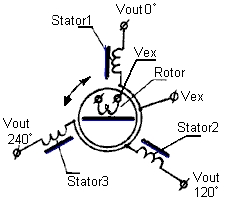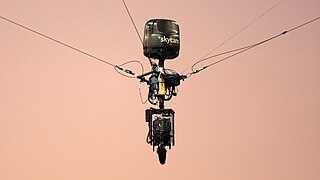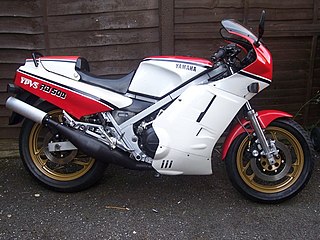
A professional video camera is a high-end device for creating electronic moving images. Originally developed for use in television studios or with outside broadcast trucks, they are now also used for music videos, direct-to-video movies, corporate and educational videos, wedding videos, among other uses. Since the 2000s, most professional video cameras are digital professional video cameras.

A synchro is, in effect, a transformer whose primary-to-secondary coupling may be varied by physically changing the relative orientation of the two windings. Synchros are often used for measuring the angle of a rotating machine such as an antenna platform. In its general physical construction, it is much like an electric motor. The primary winding of the transformer, fixed to the rotor, is excited by an alternating current, which by electromagnetic induction, causes voltages to appear between the Y-connected secondary windings fixed at 120 degrees to each other on the stator. The voltages are measured and used to determine the angle of the rotor relative to the stator.

The Nikon F6 is a 35 mm film single-lens reflex camera body that became commercially available during 2004, and is the sixth top-of-the-line professional film camera in Nikon's line since the introduction of the Nikon F in 1959. The Nikon F6 is designed by Nikon and was manufactured at their Sendai Plant.
A helmet camera, otherwise known as a micro video camera, is an action camera, usually a closed circuit television camera, attached to a helmet allowing someone to make a visual record from their point of view (POV), while keeping their hands and vision free.
Pipeline video inspection is a form of telepresence used to visually inspect the interiors of pipelines, plumbing systems, and storm drains. A common application is for a plumber to determine the condition of small diameter sewer lines and household connection drain pipes.

A parabolic aluminized reflector lamp is a type of electric lamp that is widely used in commercial, residential, and transportation illumination. It produces a highly directional beam. Usage includes theatrical lighting, locomotive headlamps, aircraft landing lights, and residential and commercial recessed lights.

Intelligent lighting refers to lighting that has automated or mechanical abilities beyond those of traditional, stationary illumination. Although the most advanced intelligent lights can produce extraordinarily complex effects, the intelligence lies with the human lighting designer, control system programmer, or the lighting operator, rather than the fixture itself. For this reason, intelligent lighting (ILS) is also known as automated lighting, moving lights, moving heads, or simply movers.

Skycam is a computer-controlled, stabilized, cable-suspended camera system. The system is maneuvered through three dimensions in the open space over a playing area of a stadium or arena by computer-controlled cable-drive system. It is responsible for bringing video game–like camera angles to television sports coverage. The camera package weighs less than 14 kilograms (31 lb) and can travel at 13 m/s (29 mph).
Mobile Autonomous Robot Vehicle for Indoor Navigation (Marvin) is a mobile robot developed at Robotics Lab at University of Kaiserslautern, Germany. This platform consists of a differential drive, a bumper for basic operational safety, planar laser range scanners at the front and back side for obstacle detection, a belt of ultrasonic sensors for recognizing jutting edges such as table tops, a web cam, another fixed laser scanner at a height of one meter for a view free of clutter and a stereo microphone system for localization of sound sources. Its control system follows a behavior-based approach and its mapping abilities rely on a 2D geometric and topological strategy.

A multifaceted reflector light bulb is a reflector housing format for halogen as well as some LED and fluorescent lamps. MR lamps were originally designed for use in slide projectors, but see use in residential lighting and retail lighting as well. They are suited to applications that require directional lighting such as track lighting, recessed ceiling lights, desk lamps, pendant fixtures, landscape lighting, retail display lighting, and bicycle headlights. MR lamps are designated by symbols such as MR16 where the diameter is represented by numerals indicating units of eighths of an inch. Common sizes for general lighting are MR16 and MR11, with MR20 and MR8 used in specialty applications. Many run on low voltage rather than mains voltage alternating current so require a power supply.

The Yamaha RD500LC is a high-performance, two-stroke sports motorcycle, also known as the RZ500 in Canada and Australia. A lightened but detuned version known as the RZV500R was developed for the Japanese home market. Strict United States Environmental Protection Agency regulations meant that the RZ500 was not available for sale in that country. Produced for a short period between 1984 and 1986 it has become a sought after collector's machine.
Document cameras, also known as visual presenters, visualizers, digital overheads, or docucams, are real-time image capture devices for displaying an object to a large audience. Like an opaque projector, a document camera is able to magnify and project the images of actual, three-dimensional objects, as well as transparencies. They are, in essence, high resolution web cams, mounted on arms so as to facilitate their placement over a page. This allows a teacher, lecturer or presenter to write on a sheet of paper or to display a two or three-dimensional object while the audience watches. Theoretically, all objects can be displayed by a document camera. Most objects are simply placed under the camera. The camera takes the picture which in turn produces a live picture using a projector or monitor. Different types of document camera/visualizer allow great flexibility in terms of placement of objects. Larger objects, for example, can simply be placed in front of the camera and the camera rotated as necessary,or a ceiling mounted document camera can also be used to allow a larger working area to be used.

Auricon cameras were 16 mm film Single System sound-on-film motion picture cameras manufactured in the 1940s through the early 1980s. Auricon cameras are notable because they record sound directly onto an optical or magnetic track on the same film as the image is photographed on, thus eliminating the need for a separate audio recorder. The camera preceded ENG video cameras as the main AV tool of television news gathering due to its portability–and relatively quick production turn-around–where processed negative film image could be broadcast by electronically creating a positive image. Additionally, the Auricon found studio use as a 'kinescope' camera of live video off of a TV screen, but only on early pre-NTSC line-locked monochrome systems.

Vari-Lite is a brand of automated, variable-colour stage lighting systems. Their intelligent lighting fixtures are commonly used in theatre, concerts, television, film and corporate events.
Stage lighting accessories are components manufactured for conventional (non-automated) stage lighting instruments. Most conventional fixtures are designed to accept a number of different accessories designed to assist in the modification of the output. These accessories are intended to either provide relatively common functionality not originally provided in a fixture, or to extend the versatility of a lighting instrument by introducing features. Other accessories have been designed to overcome limitations or difficulties some fixtures present in specific applications.

The Nikon D5100 is a 16.2-megapixel DX-format DSLR F-mount camera announced by Nikon on April 5, 2011. It features the same 16.2-megapixel CMOS sensor as the D7000 with 14-bit depth, while delivering Full HD 1080p video mode at either 24, 25 or 30fps. The D5100 is the first Nikon DSLR to offer 1080p video at a choice of frame rates; previous Nikon DSLRs that recorded 1080p only did so at 24 fps. It replaced the D5000 and was replaced by the D5200.

Caving equipment is equipment used by cavers and speleologists to aid and protect them while exploring caves. The term may also be used to refer to equipment used to document caves, such as photographic and surveying equipment. Originally, cave diving equipment was quite limited, but the increasing popularity of caving during the 20th century led to the creation of specialist caving equipment and companies.
A torque amplifier is a mechanical device that amplifies the torque of a rotating shaft without affecting its rotational speed. It is mechanically related to the capstan seen on ships. Its most widely known use is in the power steering on automobiles. Another use is on the differential analyzer, where it was used to increase the output torque of the otherwise limited ball-and-disk integrator. The term is also applied to some gearboxes used on tractors, although this is unrelated. It differs from a torque converter, in which the rotational speed of the output shaft decreases as the torque increases.

A dive light is a light source carried by an underwater diver to illuminate the underwater environment. Scuba divers generally carry self-contained lights, but surface supplied divers may carry lights powered by cable supply.











